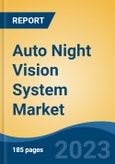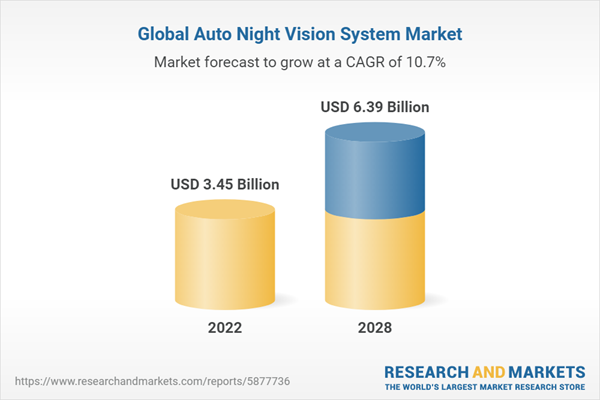Free Webex Call
The Global Auto Night Vision System Market is anticipated to expand steadily. Due to the strong economic growth, a growing elite population, technology innovation and rising concern for road accidents are some factors driving the global auto night vision market in the upcoming years. Speak directly to the analyst to clarify any post sales queries you may have.
10% Free customizationThis report comes with 10% free customization, enabling you to add data that meets your specific business needs.
A night-vision camera, also referred to as a night optical/observation device (NOD) or night-vision goggle (NVG), is an optoelectronic tool that enhances the user's night vision by enabling visualization of images in dim light. I2 (image intensification) is the process by which the device improves ambient visible light and transforms near-infrared light into visible light that the user can see. Thermal imaging, which operates in a different region of the infrared spectrum, is the term used to describe the viewing of infrared thermal radiation. An image intensifier tube, a protective housing, and possibly some sort of mounting system are the typical components of a night vision camera.
Automotive night vision system uses thermographic cameras, infrared lights, & head up displays to guide the driver to get proper vision in low light circumstances. Also, this technology helps in increasing situational awareness so that one can avoid accidents while driving by seeing the objects, animals, and people in advance.
Rising Safety Concerns
The advantages these systems provide in terms of driver safety and accident prevention are primarily driving up demand for automotive night vision systems around the world. Global demand for these systems has increased due to growing concerns over traffic accidents, especially at night. A night vision system aids in improving the driver's perception in low visibility situations by having the ability to see beyond the vehicle's headlights. Premium and luxury vehicles, which are primarily sold in China and developed nations like the United States, the United Kingdom, Germany, Japan, and Spain, have a high penetration rate of these systems. The global market for automotive night vision systems is also continuing to expand as a result of the rising sales of passenger cars with night vision systems.Technological advancements
The market demand for automotive ADAS systems is being driven by rising camera demand. Another factor propelling the market for automotive night vision systems is an upsurge in sales of vehicles with ADAS systems, which rely on automotive cameras to provide drivers with image-based inputs. The preference for surround-view cameras, which can record 360-degree images from top to bottom, is additionally contributing to the rise in demand for night vision systems. The automotive night vision system market is growing as ADAS at Level 4 and Level 5 (Full Automation) are implemented in developed nations like North America and Europe & CIS. Internal combustion and fuel-fed engines are gradually being phased out in favor of vehicles with electric, hybrid, and solar energy systems, respectively, as a result of technological advancements. The demand for manual vehicle control has decreased because of the development of autonomous technologies and the widespread use of ADAS systems. This has been made possible in large part by the advancement of in-car navigation systems. Manufacturers are focusing more on the sophisticated software that controls new mobility technologies like ADAS instead of on the actual hardware that makes up these systems.High Cost
Automotive night vision systems' high cost presents a significant challenge to manufacturers and restrains the market's expansion. Due to the high cost of components like infrared cameras, screens, and sensors, the deployment of these systems is being hampered. Additionally, equipment that can read heat or turn virtually invisible light into something visible comes at a significant cost to manufacture. The relatively low demand is another element influencing pricing. The pricey contracts that many manufacturers have also add to the cost of developing military NVGs. For military-grade models, night vision goggles can cost up to USD4,000, or about USD100. The Raytheon-designed Cadillac DeVille was available in the US as a USD2250 option from General Motors. Automakers pay less than $1,000 per unit for the recently created Autoliv technology. The cost to manufacturers and consumers could increase by USD300 if the fourth-generation version is approved.Market Segmentation
The Global Auto Night Vision System Market is segmented based on system,, component, display, region and competitive landscape. Based on system, the market is segmented into active and passive system. Based on component, the market is segment into night vision camera, controlling unit, sensors, others. Based on display the market is segmented into Instrument cluster, head-up display, and navigation display. Based on country, the market is segmented into Asia Pacific, Europe & CIS, North America, South America and Middle East & Africa.Market Players
Several major companies in the global auto night vision market are Robert Bosch GmbH, DENSO Corporation, Daimler AG, Autoliv Inc., Visteon Corporation, Magna International Inc., L3 Technologies Inc, Raytheon Company, Aisin Seiki Co Ltd, Delphi Automotive PLC, Valeo SA among others.Report Scope
In this report, the Global Auto Night Vision System Market has been segmented into the following categories, in addition to the industry trends which have also been detailed below:Auto Night Vision System Market, by System:
- Active System
- Passive System
Auto Night Vision System Market, by Component:
- Night Vision Camera
- Controlling Unit
- Sensors
- Others
Auto Night Vision System Market, by Display:
- Instrument Cluster
- Head-Up Display Sensors
- Navigation Display
Auto Night Vision System Market, by Region:
- North America
- Europe & CIS
- Asia-Pacific
- Middle East and Africa
- South America
Competitive Landscape
Company Profiles: Detailed analysis of the major companies present in the Global Auto Night Vision System Market.Available Customizations
The following customization options are available for the report:- Detailed analysis and profiling of additional market players (up to five).
This product will be delivered within 1-3 business days.
Table of Contents
1. Introduction
2. Research Methodology
3. Executive Summary
4. Impact of COVID-19 on Global Auto Night Vision System Market
5. Voice of Customer
6. Global Auto Night Vision System Market Outlook
7. North America Auto Night Vision System Market Outlook, 2018-2028F
8. Asia Pacific Auto Night Vision System Market Outlook, 2018-2028F
9. Europe & CIS Auto Night Vision System Market Outlook, 2018-2028F
10. South America Auto Night Vision System Market Outlook, 2018-2028F
11. Middle East & Africa Auto Night Vision System Market Outlook, 2018-2028F
12. Porter’s Five Forces Analysis
13. SWOT Analysis
14. Market Dynamics
16. Competitive Landscape
17. Strategic Recommendations
Companies Mentioned
- Robert Bosch GmbH
- DENSO Corporation
- Daimler AG
- Autoliv Inc.
- Visteon Corporation
- Magna International Inc.
- L3 Technologies Inc.
- Raytheon Company
- Valeo SA
- Delphi Automotive PLC
Table Information
| Report Attribute | Details |
|---|---|
| No. of Pages | 185 |
| Published | September 2023 |
| Forecast Period | 2022 - 2028 |
| Estimated Market Value ( USD | $ 3.45 Billion |
| Forecasted Market Value ( USD | $ 6.39 Billion |
| Compound Annual Growth Rate | 10.7% |
| Regions Covered | Global |
| No. of Companies Mentioned | 10 |









